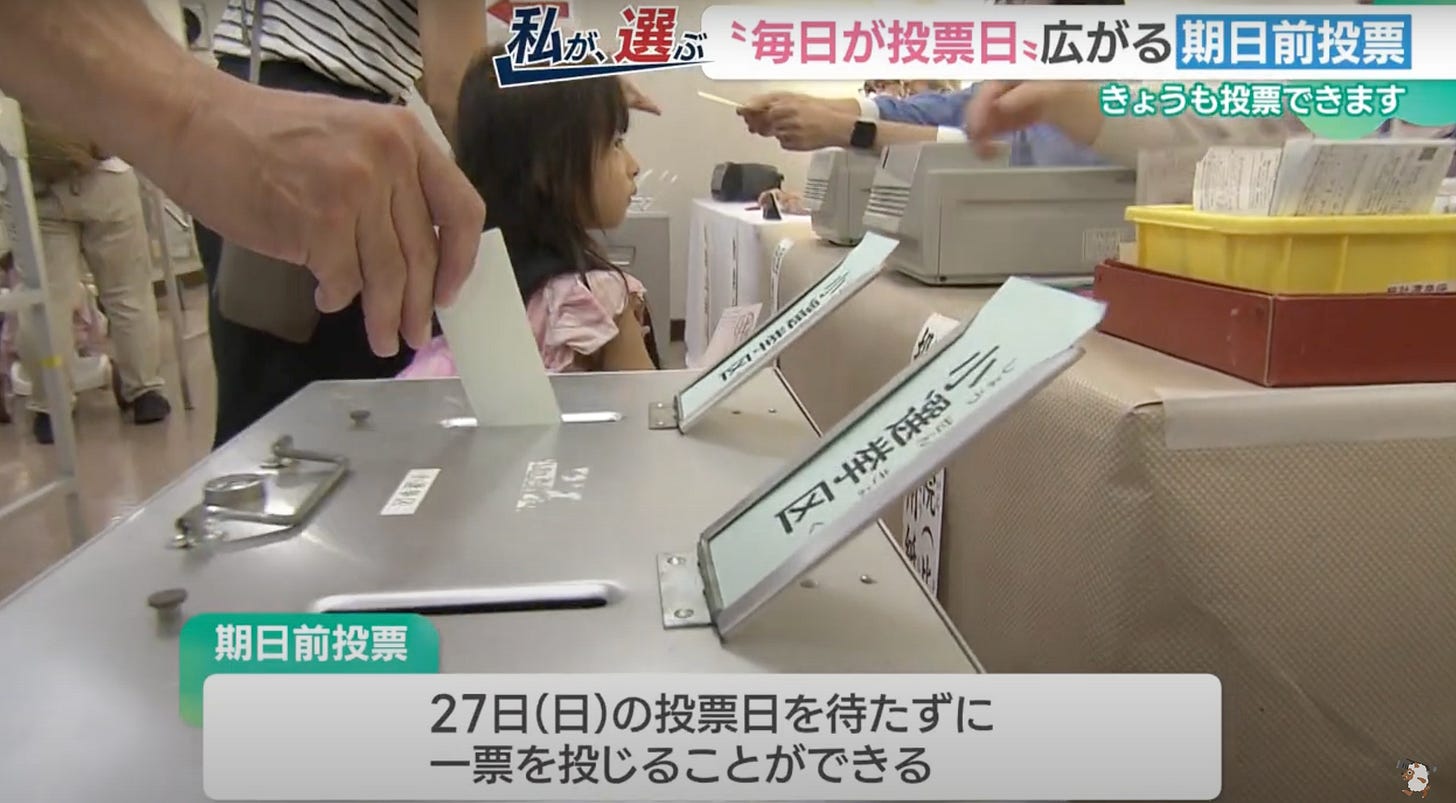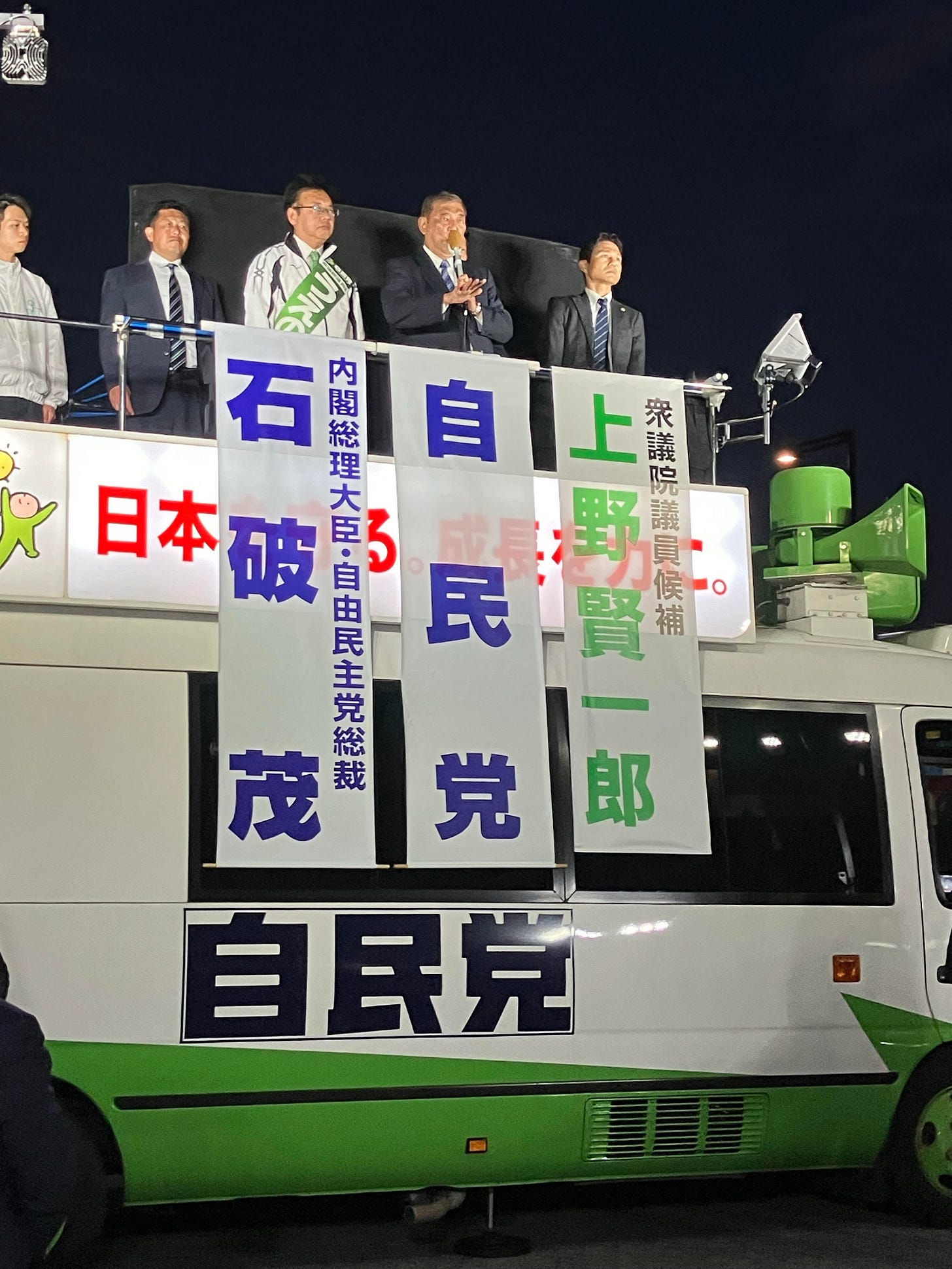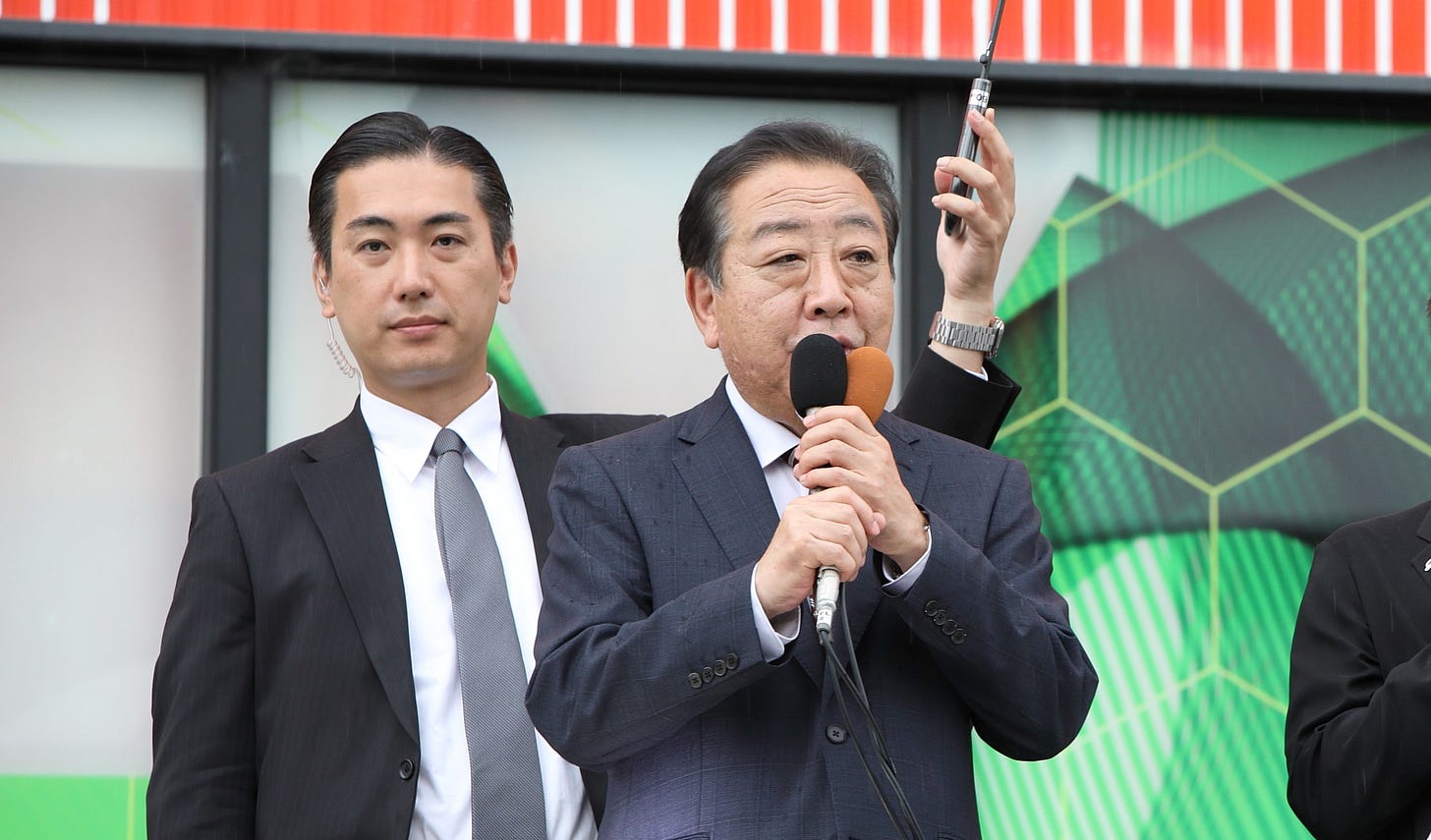Thank you for reading Observing Japan. This post is available to all readers.
If you are looking for timely, forward-looking analysis of the stories in Japans’s politics and policymaking that move markets, I have launched a new service through my business, Japan Foresight LLC. For more information about Japan Foresight’s services or for information on how to sign up for a trial or schedule a briefing, please visit our website or reach out to me.
I have published a comprehensive guide and forecast for the general election, available for paying subscribers here. The guide is also available for purchase here.
I recently appeared on two podcasts: The Market Huddle (in conversation with Kevin Muir from The Macro Tourist) and The IRF podcast.
In case you missed it, I also had an article at Foreign Policy on Ishiba and his challenges.
Campaign stops
On Tuesday, Ishiba Shigeru will be campaigning in Aichi prefecture all day, where the CDP is poised to make meaningful gains. Koizumi Shinjirō will be in Tochigi-4 and Aomori’s three single-member districts. LDP Secretary-General Moriyama Hiroshi will be in Chiba-9, Ibaraki-1, and Ibaraki-7. (LDP schedules here)
CDP leader Noda Yoshihiko will be in four Saitama constituencies and Tochigi-4. Senior advisor Edano Yukio will be in Tochigi-1, Tochigi-3, and Fukushima-1. (CDP schedules here)
DPFP leader Tamaki Yūichirō will be in Kanazawa, Toyama, and Nagano before returning to Tokyo; Ishin leader Baba Nobuyuki will be in Fukuoka and Yamaguchi; Reiwa Shinsengumi leader Yamamoto Tarō will be in Okinawa.
Voting
The Ministry of Internal Affairs and Communications reported on 21 October that early voting is down 17% relative to where it was a week before the general election in 2021. As of 20 October, 4,671,503 people had voted, which is only 4.5% of the electorate. The total was lower in thirty-four of forty-seven prefectures. Lower early voting does not necessarily predict overall turnout or voter enthusiasm, however.
A new poll from NHK found that 51% said that they will definitely vote, while another 8% said that they had already voted; 26% say that they will probably vote. The 59% who said that they have already voted or will definitely vote is five percentage points higher than the previous NHK poll. 76% of respondents said that they are greatly (32%) or somewhat (44%) interested in this election. Meanwhile, 34% say that they want the opposition’s seats to increase, compared with 18% who say that they want the ruling coalition’s totals to increase and 41% who cannot say.
Kyodo News, meanwhile, found that the gap in voting intention for the PR ballot is only 8.5 percentage points between the LDP’s 22.6% and the CDP’s 14.1%. The poll also found that 33.2% said that they would vote for an opposition candidate in their constituency, compared with 24.6% who would vote for a ruling party candidate. The poll found that 41% are still undecided.
The Liberal Democratic Party
With less than a week until the election, Prime Minister Ishiba Shigeru acknowledged predictions that the ruling coalition could lose its absolute majority and insisted that his party will “fight the last six day with an overwhelming sense of urgency.” As a sign of the LDP’s urgency, LDP Secretary-General Moriyama Hiroshi suggested that the LDP could bring in additional coalition partners/
After a forty-nine-year-old man was arrested when he hurled Molotov cocktails at the LDP’s headquarters in Tokyo and then crashed into a fence at the Prime Minister’s residence, Ishiba, who was away from Tokyo campaigning at the time, said in response, “Democracy must never be allowed to succumb to violence.” Nevertheless, violent incidents dating back to Abe Shinzō’s assassination in 2022 are influencing how politicians campaign.
The prime minister spent the first week of the campaign traveling across ten prefectures, with stops mainly in less populated rural regions similar to his home prefecture of Tottori, while Koizumi Shinjirō, the LDP’s election strategy chief, has been campaigning in urban districts. Over the next week, party leaders are planning to focus their efforts on roughly 40 constituencies as they seek to preserve as much of the ruling coalition’s majority as possible.
The LDP’s factions may be mostly defunct, but faction bosses are still campaigning on behalf of their former factional colleagues. Asō Tarō, Kishida Fumio, and Motegi Toshimitsu have been traveling up and down the country to help their factions’ members survive.
The opposition
Asahi reports that despite the significant increase in opposition candidates – discussed here – the proliferation of multiple opposition candidates is not necessarily undermining the chances of opposition parties gaining at the ruling coalition’s expense. What is unclear is why, whether it is a function of more strategic voting for the electorate; Ishin no Kai’s inability to raise its profile outside of Kansai; stagnating support for the Japanese Communist Party; or renewed public interest in the Constitutional Democratic Party with Noda Yoshihiko as its leader. The upshot could be a greater degree of consolidation in the non-LDP vote in single-member districts even with multiple non-LDP candidates running.
DPFP leader Tamaki Yūichirō, asked whether he would consider joining a coalition government with the LDP and Kōmeitō in the event that they failed to secure an absolute majority in the House of Representatives, said “absolutely not at this time,” albeit qualifying his refusal by saying that it is unknown what the situation will look like after the election.
Separately, CDP leader Noda Yoshihiko rejected the idea that the LDP could bring the DPFP or Ishin no Kai into government and said that he hoped that they could continue to cooperate on policy.
One of the most significant changes in this election campaign – with potential national implications – is the breakdown of a truce between Ishin no Kai and Kōmeitō in Osaka, where in the past Ishin had declined to run candidates against Kōmeitō’s candidates in Osaka single-member districts. That truce has collapsed, and the two parties’ candidates are now competing in four of nineteen districts in the prefecture. As Asahi reports, neither party can take its past sources of strength – Kōmeitō’s “organized vote” versus Ishin’s strong grassroots following in Kansai – for granted. If Kōmeitō cannot defend its seats in Osaka, it could be the difference between the ruling coalition’s security a majority or not.
The issues
In response to Prime Minister Ishiba’s call for a debate within the ruling coalition on including tax increases (proposed by former prime minister Kishida) to pay for higher defense spending in the FY2025 budget, opposition parties have questioned the prime minister’s timeline and whether tax increases are appropriate at this time (or necessary at all to pay for higher defense spending). If the ruling coalition’s losses are as large as has been suggested, this debate is likely a non-starter.
Mainichi Shimbun conducted a survey of all 1344 general election candidates, receiving replies from more than 90%. Some data points: 15% of LDP respondents said it is not necessary to uncover the truth about the party’s kickbacks; only 13% of all candidates support tax hikes for defense, but 39% of LDP candidates and 56% of Kōmeitō do (while CDP candidates are divided between opposing the tax hikes to pay for them and opposing the spending hikes altogether); 76% and 94% of LDP and Kōmeitō oppose the possession of nuclear weapons, but 34% of LDP candidates (and 82% of Ishin no Kai candidates) want to examine nuclear sharing, even as CDP candidates overwhelmingly oppose both options; and 62% of all candidates favor allowing separate surnames for spouses, but the LDP is divided, with 32% opposed, 30% in favor, and 37% not answering the question.
Further reading
Nikkei looks at Hagiuda Kōichi’s fight for his political life in Tokyo-24.
As part of a series looking at “change” elections past, Mainichi examines the 1993 general election.
Mainichi also considers the continuing role of hereditary politicians.






